Customers don’t accept any experience other than stellar anymore. If something isn’t up to their standards, they find an alternative to your product and switch to it with little to no hesitation.
Customer experience (CX) spans many different domains – from product usability to the quality of support, and from social media communications to product demos. Naturally, there’s a variety of customer experience tools aimed at each of those domains that you should use to ensure your customers are happy with all of them.
In this article, we wanted to share a curated list of the best customer experience tools for all those different purposes. All of these tools have one thing in common though – we use them in our daily work to make sure Mouseflow is always up to your standards.
Let’s go through the different types of customer experience platforms we’ll be covering first.
Types of Customer Experience Tools
You have plenty of options for customer experience tools, each offering something special:
- Customer experience analytics: These tools offer website analytics, but go beyond basic data collection—they provide in-depth insights into customer behavior, sentiment, and feedback. CX analytics tools’ main purpose is to improve customer experience on your website (whether it is an eCommerce store, a SaaS app, or something else). Examples: Mouseflow, Glassbox, Contentsquare.
- Customer Relations Management (CRM): CRMs provide a centralized platform for managing all customer interactions, which include sales inquiries, service requests, and customer preferences. Collecting and managing this data in one place helps build better customer relationships.
Examples: Hubspot CRM, Salesforce, Pipedrive.
- Customer experience management (CXM) platform: Think of a CXM platform as an all-in-one command center for customer experience. It integrates various functionalities like customer feedback, analytics, and engagement tools, offering a unified view of the customer journey. CXM platforms’ main goal is to support and maintain existing customer relationships.
Examples: Hubspot Service Hub, Zendesk, Adobe Experience Cloud.
- Customer support: These solutions typically simplify handling customer inquiries and resolving issues. The most common features such tools offer are ticketing systems, live chat, and knowledge base management, allowing for efficient support across various channels. They are pretty similar to CXM platforms, but with more support-focused functionality.
Examples: Zendesk for Service, Freshdesk, Intercom.
- Social listening: These tools monitor social media conversations to understand customer sentiment and brand perception. With social listening, businesses can identify emerging trends, address customer concerns promptly, and engage with their audience in real-time. Social listening is pretty important for customer experience both before and after the acquisition stage.
Examples: Brandwatch, Mention, BrandMentions.
- Interactive Demo: Demo tools allow businesses to create interactive demonstrations of their products. These self-guided experiences allow potential customers to explore functionalities firsthand before committing to buying a product.
Examples: Navattic, Storylane, Reprise.
How to Choose The Right Customer Experience Tools
It’s very easy to explain why it’s worth focusing on CX—companies that prioritize customer experience see a 60% increase in profits compared to those who don’t. But achieving this level of success requires the right customer experience management tools. The next section will guide you through the process of selecting the perfect CX toolkit for your business needs.
Spoiler alert: One tool would not be enough, just because of how many different areas these tools cover. Even if you pick a Swiss army knife kind of tool like Hubspot, there would still be areas that it doesn’t cover.
Scalability
It’s quite important to have a tool that can grow together with your business. It should be able to handle more customer interactions, data, and integrations without slowing down or becoming overwhelming.
Scalability is equally important for fast-growing companies (or those with seasonal changes in demand) and big corporations. Sometimes another department in your organization starts using the same tool—and it needs to be able to handle the influx of requests and support good teamwork while providing some degree of separation.
Integrations
A customer experience tool should easily connect with other tools in your tech stack, including other customer experience tools like your CRM and analytics tools. Good integrations prevent data silos, improve teamwork, and offer centralized data storage and processing.
The more integrated the tool, the less manual work is required, making it more useful.
Pricing
That’s an obvious one – you need a tool that fits your budget. But the total cost includes more than just the upfront price—think setup fees, subscriptions, and costs for scaling or adding features. If in doubt, weigh the cost against the return on investment (ROI) in terms of customer satisfaction, retention, and revenue.
Functionality Overlap
With customer experience tools, it’s important to consider how their features overlap. Like, do you really need Zendesk when you already have HubSpot? Too much overlap can lead to wasted resources, as you may end up paying for redundant capabilities.
And even if you like the tool that has a huge overlap with your current stack, chances are that your request for buying it will get stuck in the procurement department which will require more justification than you can provide.
Security and Compliance
Customer experience tools operate with customer data, which, according to many different regulations, should be processed and stored responsibly. So, depending on the regions you work with, you need to prioritize compliance with certain data privacy and security regulations, starting with omnipresent GDPR and CCPA.
For industries like healthcare or finance, meeting standards like HIPAA or PCI DSS is a must. The tool you’re choosing should be compliant with all the standards you need to comply with.
Ease of Use
This one also is a no-brainer: if a customer experience tool is too hard to use, likely, its creators don’t understand something about what customer experience is.
That’s not only about the user interface; it’s also about offering helpful tutorials and high quality support.
8 Best Customer Experience Tools That We Use Ourselves
Now, let’s get into the details of these customer experience tools. We’ll break down each one, showing you what they do best and why we think they’re worth your time.
1. Intercom
Intercom is a popular customer communication platform that offers an omnichannel solution for engaging with customers across various touchpoints, including live chat, email, SMS, phone, and social media platforms.
It helps businesses simplify their customer interactions, improve engagement, and provide efficient support throughout the customer journey. Intercom’s main function is providing customer support, but that’s by far not the only use case.
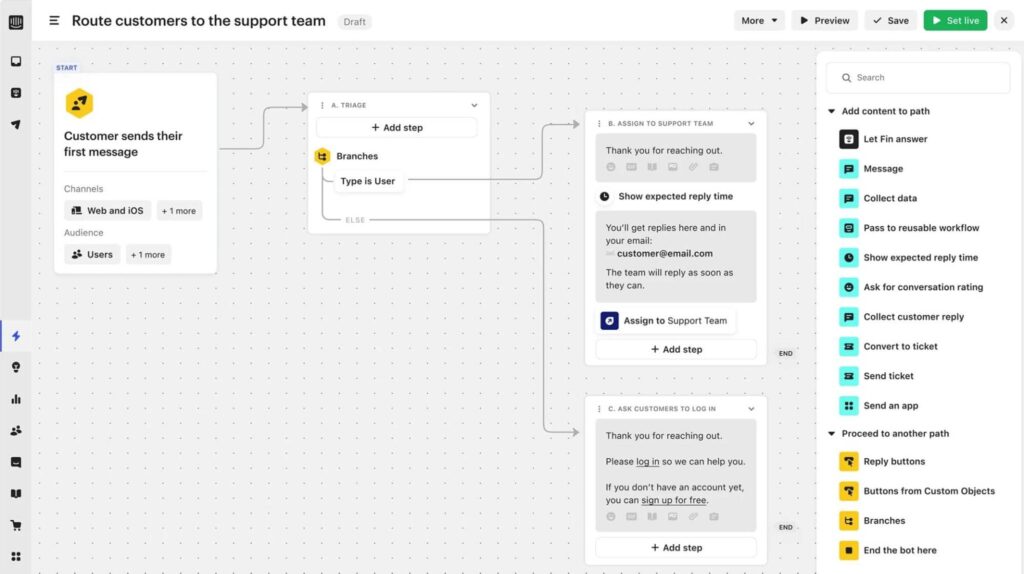
Here’s a detailed look at Intercom’s key features and how they contribute to improving customer experience:
- Omnichannel communication:
- Live chat for real-time website and in-app support
- Email support for longer, more detailed interactions
- SMS capabilities for quick updates and notifications
- Phone support integration for voice-based customer service
- WhatsApp integration for global messaging support
- Multilingual capabilities:
- Support for 45 languages out-of-the-box
- AI-powered language detection and translation
- Localized user interfaces for global customer bases
- In-app chat:
- Customizable chat widgets for web and mobile applications
- Targeted messaging based on user behavior and attributes
- Rich media support (images, videos, GIFs) in chat conversations
- Help center and knowledge base:
- Customizable self-service portal for frequently asked questions
- Searchable knowledge base for customer self-help
- AI-powered content suggestions for relevant articles
- AI-powered features:
- Fin AI Agent for automated issue resolution
- Chatbots for handling routine inquiries and routing complex issues
- Team collaboration tools:
- Shared inbox for streamlined team communication
- Assignment and routing rules for efficient ticket management
- Internal notes and mentions for seamless teamwork
✅ Ideal for: Customer success and support teams
❌ Free plan: No (but offers a 14-day free trial)
✅ Why we like Intercom: For us, Intercom covers everything related to success and support plus some product-related things such as customer discovery. Our help center works on Intercom, so does our in-app support with some built-in automations, in-app onboarding, etc. Since Intercom is our main channel of communication with customers, we run some in-app surveys with it as well and arrange conversations with customers to know better what they need. It’s a very flexible tool that is really good at almost everything support-related.
☝️What improvements does Intercom need: Intercom’s knowledge base is extremely easy to use, but it’s not well suited for SEO. Articles don’t have meta descriptions, they often don’t get indexed at all or barely rank. Intercom could use some SEO.
2. Mouseflow
Mouseflow—our own solution—is a behavior analytics platform that provides deep insights into user interactions on websites and digital products. It combines tools for tracking user behavior, visualizing customer journeys, and collecting and analyzing customer feedback to help businesses optimize the digital experience.
And yes, we use our own platform ourselves, of course, including for customer experience improvements.
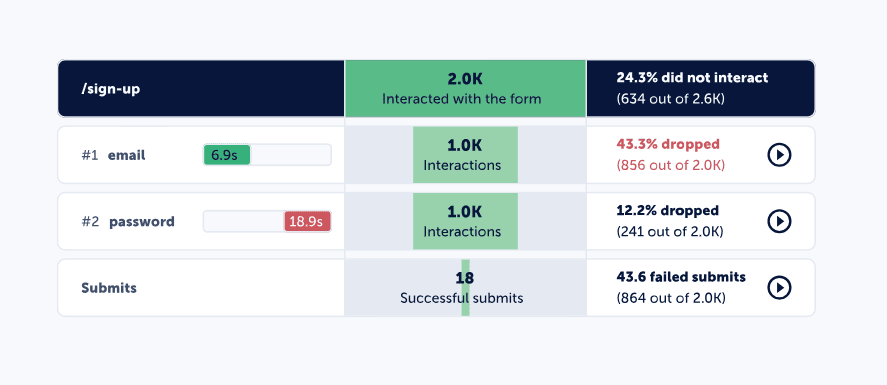
Here’s a detailed overview of key Mouseflow features:
- Heatmaps and session replay: Mouseflow offers a session replay tool and a heatmap tool to help understand how visitors interact with your website and web app. Heatmaps provide a visual representation of where users click, move, and scroll on a page, highlighting areas of high engagement. This feature helps identify usability issues, confusing navigation paths, and other barriers to conversion that might not be apparent from analytics alone. Session replay that allows you to watch recordings of actual user sessions adds depth to all insights gathered from quantitative analytics or heatmaps. Watch this YouTube video to understand Mouseflow’s session replay feature.
- Form analysis: Mouseflow tracks every interaction users have with forms on your website. It records which fields users fill out, where they hesitate, and at which points they abandon the form. You get detailed analytics for each form field and see metrics like completion rates, time spent on each field, and common errors. You can also create visual representations of where users tend to drop off in your forms. This will help you quickly identify the stages of your forms that are causing the most friction or abandonment.
- Segmentation capabilities: Using Mouseflow, you can create custom segments based on different criteria, including tags, UTM parameters, traffic sources, geographic regions, and marketing campaigns. This granular segmentation lets businesses visualize data across their entire ecosystem for specific user groups. Then, by understanding how different segments interact with your digital properties, you can fine-tune your approach to meet the unique needs of various customer groups.
- User feedback tool: Mouseflow allows you to create different kinds of surveys – from short NPS and CSAT to long questionnaires with several questions of different types.
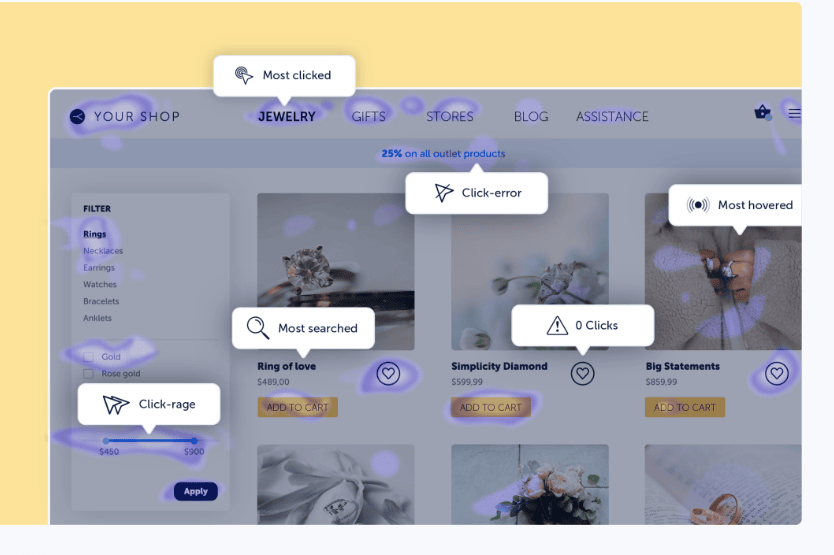
👉 Check out this case study to learn how Derek Rose improved their customer experience with Mouseflow.

At Mouseflow, we eat our own dog food – or drink our own champagne if you prefer some bubbles (like me). We use our own product to measure, analyze, and improve our website and customer experience. I have custom tags, filters, and notifications set up that alert me when customers are encountering issues or frustrations on our site.
We do quarterly reviews of our customers’ experience built on the data from Mouseflow, and we continuously evaluate and refine our pages to provide the information and functionality our customers need.
✅ Ideal for: Product managers, UX professionals, marketing managers, and eCommerce brands
✅ Free plan: Yes. You can sign up here.
✅ Why we like Mouseflow: Mouseflow shows us exactly how people use our website. We use it to make sure there is no critical friction happening on our website and also regularly watch session replays to understand the “why” behind paths that our website visitors take. We also use our own platform to optimize paid campaigns, but that’s a different story.
3. Mixpanel
Mixpanel is a powerful product analytics platform that helps businesses understand user behavior and improve their digital products. It provides deep quantitative insights into how customers interact with websites and apps, which enables data-driven decision-making to enhance user experience.
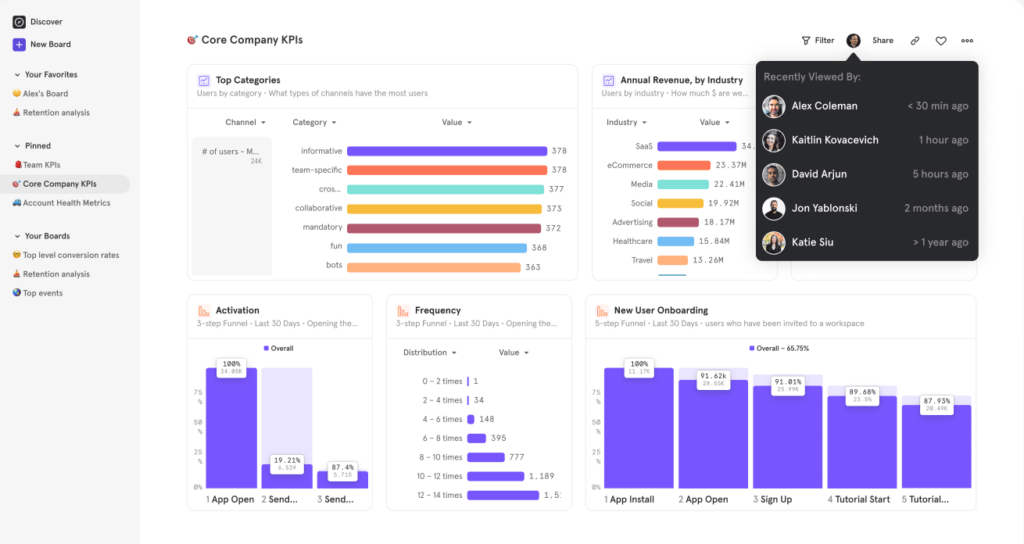
Key features of Mixpanel include:
- In-depth quantitative analytics:
- Real-time event tracking and analysis
- Custom metrics and KPI tracking
- Funnel analysis to identify conversion bottlenecks
- Retention analysis to measure user engagement over time
- User segmentation analysis:
- Dynamic cohort creation based on user behaviors and attributes
- Comparative analysis between different user segments
- Customizable segmentation criteria for targeted insights

Mixpanel is one of the easiest analytics tools to use, while still packing a solid set of features to help you understand your users. The dashboards make it simple to keep track of your operations, and the ability to view cohorts or individual user actions offers a clear, detailed look at what’s happening in your product.
✅ Ideal for: Product teams, data analysts, UX researchers, and growth marketers
✅ Free plan: Yes
✅ Why we like Mixpanel: Mixpanel gives you everything you may want from a quantitative analytics tool. It’s great for spotting trends and understanding different groups of users – and a good starting
4. Hubspot
HubSpot is a comprehensive customer relationship management (CRM) platform that integrates marketing, sales, and service tools into a single ecosystem. It enables businesses to manage and optimize their entire customer lifecycle, from initial attraction to long-term retention.
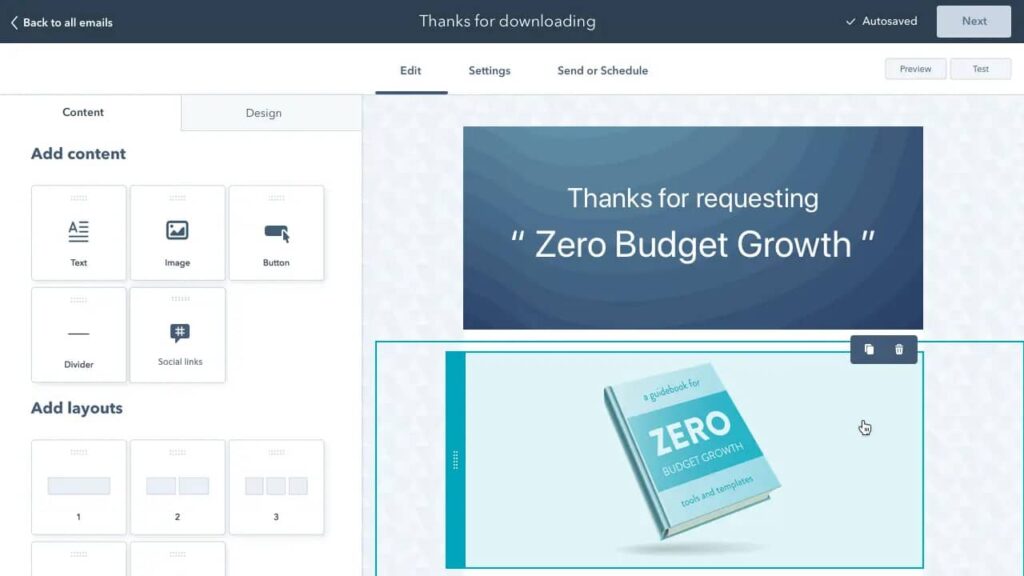
Key features of HubSpot that enhance customer experience include:
- Customer Relationship Management (CRM):
- Centralized database for all customer interactions and information
- 360-degree view of each customer’s journey and touchpoints
- Automated data entry and enrichment to keep records up-to-date
- Customizable pipelines and deal stages for sales process optimization
- Email personalization:
- Dynamic content insertion based on customer data and behaviors
- Segmentation tools for targeted email campaigns
- A/B testing capabilities to optimize email performance
- Customer service hub:
- Ticketing system for efficient issue tracking and resolution
- Knowledge base creation for customer self-service
- Feedback surveys to gather customer insights
- Service analytics to measure team performance and customer satisfaction

As a CRM tool, HubSpot is a great place to maintain relationships with customers. One of the ways we use HubSpot is by engaging our audience with relevant and personalized content based on their personas and actions. By tracking key events from our own product, we use workflows to trigger timely and valuable content for our users.
For example, depending on their behavior, we can send them information about installation, the right tutorials, and so on. HubSpot’s smart rules in emails allow us to send personalized messages based on the user persona or their interaction with us. With HubSpot, we can interact with our customers in a meaningful and supportive way, improving our relationships with them.
✅ Ideal for: Marketing managers, sales teams, and customer success managers
✅ Free plan: Yes
✅ Why we like Hubspot: HubSpot keeps all our customer info in one place. Our sales and marketing teams work with it every day to create personalized experiences for both prospective and current customers.
5. Mention
Mention is a comprehensive social listening and media monitoring tool that enables businesses to track their brand presence across various online platforms. Mention allows you to promptly respond to customer feedback and enquiries, address concerns, and engage with the audience across multiple channels.
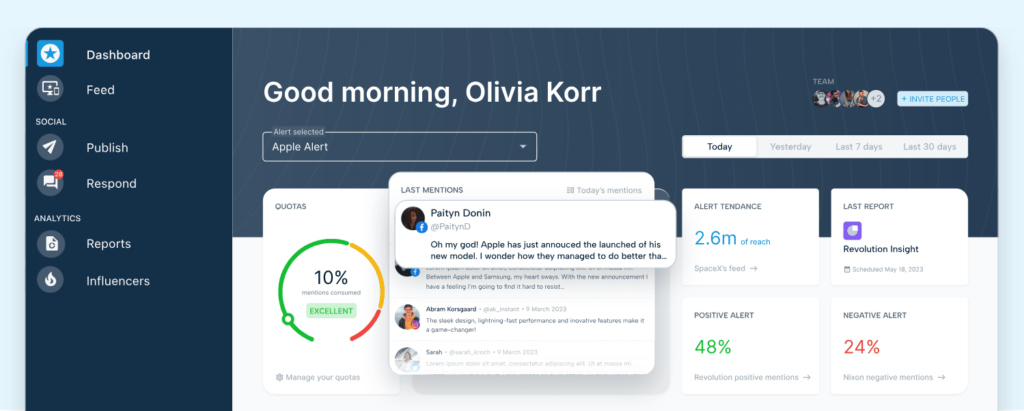
Let’s see its key features below:
- Social media monitoring:
- Real-time monitoring for immediate response capabilities
- Historical data access up to 2 years for trend analysis
- Advanced alerting system for customized monitoring
- Sentiment analysis:
- Automatic classification of mentions as positive, negative, or neutral
- Trend tracking to identify shifts in brand perception
- Language-specific sentiment analysis for global brands
- Analytics:
- Comparative analysis of competitor data against your own metrics
- Customizable comparative reports for benchmarking
- Social analytics reports for individual brand accounts
- Performance metrics tracking (engagement rates, reach, share of voice)

We need to be quick to react on social networks – be it when interacting with our community or monitoring our competitors and important keywords.
Mention covers all of that, tracking and notifying us about what everyone is saying about our brand or competitors as soon as it happens. With a social listening tool like Mention, we can quickly join conversations and address concerns without constantly keeping an eye on multiple tabs.
Also, not all users share their Mouseflow-related problems directly with our support team. Some prefer to raise them on social platforms. With Mention, we can help them quickly – and understand trends and feedback better at the same time.
✅ Ideal for: Social media managers, PR professionals, and brand managers
❌ Free plan: No (but offers a 14-day free trial)
✅ Why we like Mention: This tool keeps us in the loop about what people are saying about Mouseflow and our competitors online, whether it’s a tweet, a blog post, or a forum comment.
6. Lyssna (formerly Usability Hub)
Lyssna is a user testing and research platform that helps businesses optimize their digital products through user insights. Lyssna allows you to improve customer experience by identifying and addressing usability issues early in the design process. This proactive approach leads to more intuitive interfaces, smoother user journeys, and higher engagement with digital products.
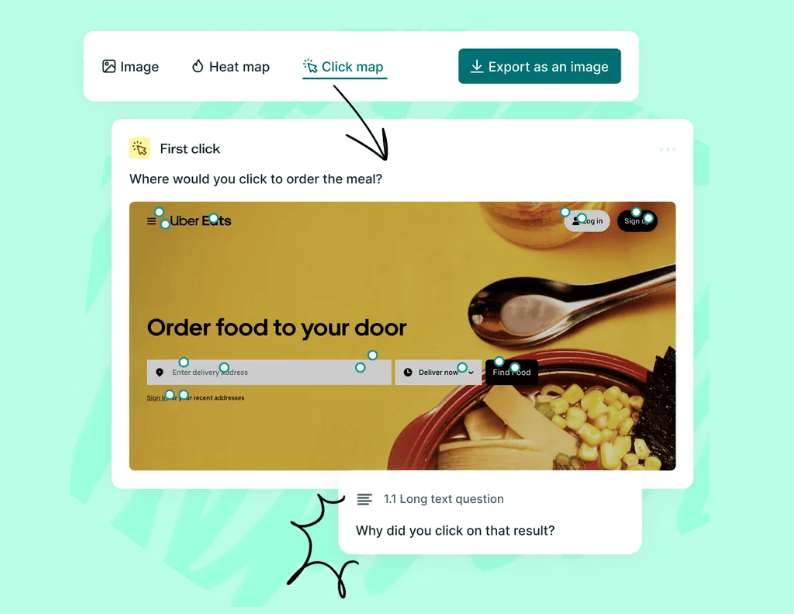
Here are some useful Lyssna features:
- First click testing:
- Analyze initial user interactions with designs or interfaces
- Measure the intuitiveness of design layouts
- Prototype testing:
- Evaluate interactive Figma prototypes at various design stages
- Uncover areas for improvement before the product launch
- Auto grouping of results for efficient data analysis
- Results filtering for focused insights on specific user segments
- Additional testing types by Lyssna:
- Five-second tests for first impressions
- Preference tests to compare design alternatives
- Card sorting for information architecture optimization
- Tree testing to evaluate navigation structures
✅ Ideal for: Product managers, mid-senior level UX professionals, and digital designers
✅ Free plan: Yes
✅ Why we like Lyssna: Lyssna lets us test our designs before we actually build them. It’s cool to see where people click first—it helps us make our product easier to use.

In 2022, we went through a rebranding and relaunched our website. And we absolutely needed to know if that massive overhaul is something that our website visitors would welcome. We used Lyssna (Usability Hub back then) to test our assumptions regarding anything from messaging and brand positioning to website navigation and UI design. The ideas that the testers liked are right in front of you, implemented on our website.
7. Storylane
Storylane is a no-code demo platform that allows businesses to create interactive product demos without requiring technical expertise. SaaS businesses use product demos to showcase product features and functionalities.
Product demos enhance customer experience by allowing potential users to explore product features in a hands-on manner before committing to a trial. These demos actually reduce the learning curve and increase user confidence, leading to a smoother onboarding process for new customers.
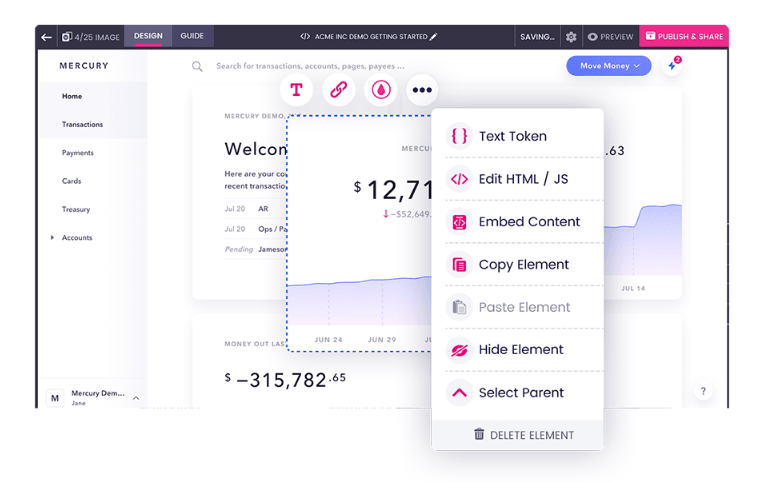
Here are some Storylane functionalities that you’ll enjoy using:
- One-click editing:
- Intelligent copy/paste functionality for elements
- Embedding options for diverse content (video, audio, PDF, maps, etc.)
- Graph alteration capabilities
- Smart blurring, hiding, or deletion of sensitive data
- Enhanced demo interactivity:
- Lead form integration within demos
- Video clip insertion for improved user experience
- Multi-feature showcase within a single demo
- Automatic voiceover addition to demos
- Customization:
- Demo guide translation into 25+ languages
- Screen cloning to the code level for detailed replication
- Conference mode activation for offline demo access
- Collaboration and efficiency tools:
- Team collaboration features for streamlined demo creation
- Analytics for tracking demo performance and user engagement
👉 Here’s an example of how we used Storylane to create a Mouseflow demo for new customers.

Storylane offers great analytics on demo consumption that helps you optimize your interactive demo experience. Plus, their Slack and HubSpot integrations make it simple to track who’s checking out your demos and improve lead scoring.
✅ Ideal for: Product teams, sales and pre-sales teams, and demand-generation marketers
✅ Free plan: Yes
✅ Why we like Storylane: Storylane is our go-to for creating product demos without the tech headaches. We can show off lots of features in one go, which helps explain our product better. We also started using it on our Help Center to make support articles more visual.
8. Productboard
Another platform we love using is Productboard which is a product management solution that centralizes customer feedback and product planning. It enables product teams to make data-driven decisions, prioritize features effectively, and create strategic roadmaps for product development.
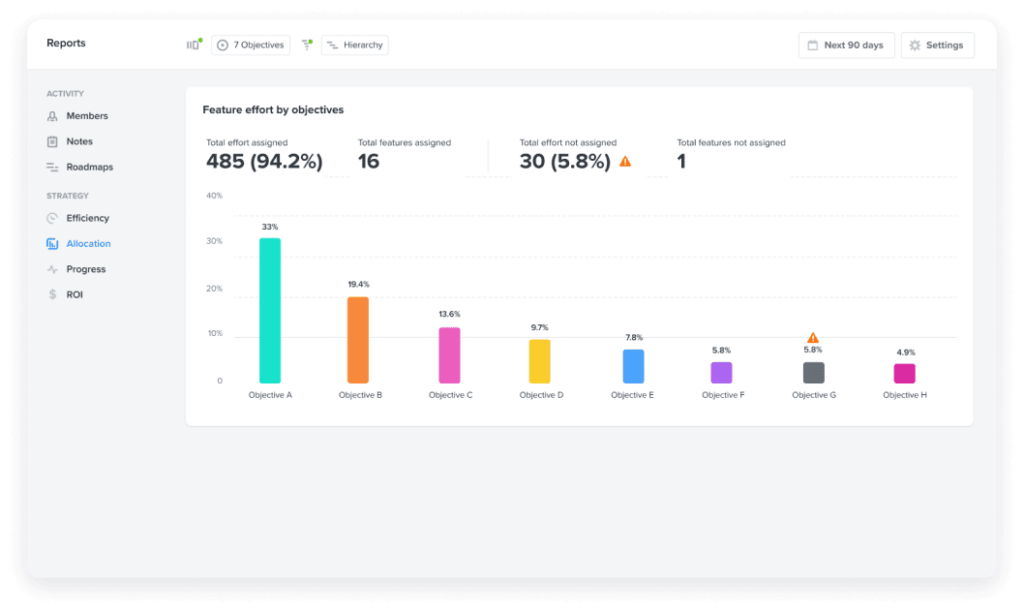
Key features of Productboard include:
- Product roadmap creation:
- Build dynamic roadmaps for visualizing product strategy
- Align with go-to-market teams for coordinated efforts
- Launch coordinated releases across multiple products or features
- Customize views for different stakeholders and timeframes
- Track progress and adjust plans in real-time
- Customer insights:
- Centralize user feedback from various sources (e.g., support tickets, surveys, interviews)
- Analyze feedback at scale to identify trends and priorities
- Tag and categorize insights for easy reference and analysis
- Link customer feedback directly to feature ideas and initiatives
✅ Ideal for: Product managers and customer success managers
✅ Free plan: Yes
✅ Why we like Productboard: Productboard helps us decide what to build next based on what our customers want. It keeps everyone on the same page about our product plans.
Conclusion
These are the eight customer experience tools that we use or used ourselves and that we generally can recommend.
Of course, everything depends on your needs, your other tech stack, and a million other things. Generally though, to be successful, you need to be customer-centric, which means that you’ll need some customer experience tool for each side of your business.
We hope that the suggestions we’ve given will help you find the right customer experience toolstack for your business.


